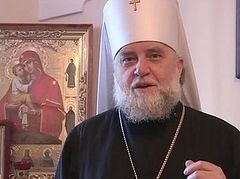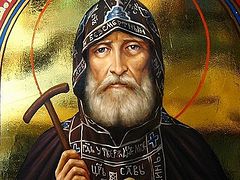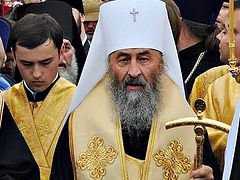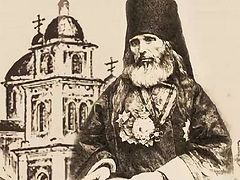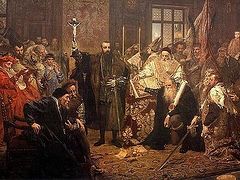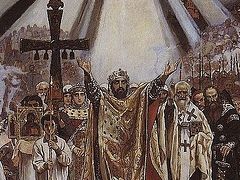This assessment and comparison of persecutions against the Church in Ukraine by the Poroshenko government today and its persecution by the Polish-Lithuanian Commonwealth after the Brest Unia in the sixteenth century was offered by Archpriest Andrei Tkachev, who was born and raised in Lvov, the center of Western Ukraine and the stronghold of Greek Catholicism (Uniatism).
The methods of war against the Church in Ukraine were developed as far back as the times of the Brest Unia. Some things have changed, but not much.
1. Crude meddling by the government authorities.
Then it was Sigismund III and his followers—furious ideological enemies of Orthodoxy. Today even more despicably it is the “democratic” government in Ukraine, where the Church and state are separate by law and religious partiality is in principle contraindicated to a president by the Constitution.
And it is very hard, I’ll tell you, to go against the government’s pressure. This Leviathan has a thousand paws, tails, and tentacles. It has only one (insatiable) belly and absolutely no conscience.
2. Handing out “spiritual bread”.1
These are cathedras and other positions handed out “for material support” to people who showed loyalty to the government. That was the practice in the Polish-Lithuanian Commonwealth. Servants of the crown were given monasteries and apiaries, river rights, hayfields and so on, be they Calvinists or atheists. Thus were loyal servants of the sovereign and true enemies of the Church also repaid. Today they will be trading in cathedras and luring in apostates.
Moreover these “candidates” have no spiritual dimension. And the more sinful they are, the better. It is more advantageous to give spiritual authority to a loyal sinner than to an intractable righteous man.
The seventeenth century Catholics knew what they were doing.
3. A common center of influence and rule.
Then it was Rome, “where all roads lead”—Rome and the kings who were loyal to the apostolic throne. That is where in those times they learned to reel in the apostates (by the way, that is where Bartholomew studied—in the West). Through education and government lobby they learned how to form the new elite.
Today this work is being done by Washington along with Rome: There they accept oaths of fealty, purvey knowledge along with promises of future employment, gather dossiers with compromising information, disseminate money, provide documents to deserters and so on. At some stage Rome and Washington were joined by Instanbul in the person of a number of patriarchs bearing the title of a city that has disappeared.
4. Revocation of governmental registration.
The Polish authorities’ pressure on the bishops after signing the Unia led to almost all the bishops leaving for the Unia. Some did it from fear, others in a grab for privileges. By 1620 only the clergy and monastics were left—and the people. But there can be no Church without bishops. Patriarch Theophan of Jerusalem arrived and renewed the lawful hierarchy, ordaining new bishops. He was immediately accused of being an agent... of whom? Istanbul! And only under the protection of the Cossacks was he able to stay alive and leave the borders of the Polish-Lithuanian Commonwealth.
5. There is one more thing: total disdain for ordinary religious people.
The thought was simple: “What do those goatherds and buckwheat reapers understand about dogmas and rites? We, the overlord bishops—the Church instructors—do what we consider necessary. They—the Church instructed—will in time unavoidably have to submit. Then it’s all in the bag.”
That is what they thought and that is what many now think.
Disdain for the simple folk is in the handwritten ABCs of, for example, any bureaucracy with its talmud of laws, where any ordinary person will sooner break his leg. This is also the norm for heresiarchs. “We will sign”, they say, “for we have the power and know very much, but they, those simpletons—let them endure and submit. That is their part in Church matters.” “We are concerned with a certain common good, only we understand, and concerned with this or that, we decide matters as such. All the rest are supposed to accept what has happened as unavoidable.”
That is how all heresiarchs act. That is how Bartholomew acted before our very eyes.
Sitting in their golden cages, heresiarchs assume for themselves the right to act and decide matters on behalf of millions of ordinary people—although one part of those people can’t stand them, while the other has never laid eyes upon them.
In Ukraine this system broke down back in the seventeenth century. God willing it will break down again.
To counteract the government’s outrages and venal bishops the harassed people then united into brotherhoods. It is worth looking into the history of brotherhoods in Lutsk, Lvov, and Vilnius in order to get a picture of a clear dogmatic awareness and authentic religiosity amongst the ordinary tradesmen in those cities at that time. They corresponded with the hierarch who was their head back then, the Patriarch of Constantinople (for which they were labeled by the government as “agents of the Turkish Sultan”), organized theological schools, published books, collected money for this, and in general behaved themselves so consciously and actively that it would be hard to find any analogy in history.
The laity turned out to be wise and faithful—without the internet or even widespread literacy. There is great hope that today this succession will continue, taking however into consideration our minuses—the general lapse in religiosity. But there are pluses—the opportunity to become broadly informed through modern technologies. And we are the same in soul now as then.
The monasteries play a special role
If learned theologians took sides with the Uniates, Jesuit preachers, and so on, then on the side of Orthodoxy stood the monks, not glittering with scholastic education. Thus the “faith of the simple and righteous—monks of the Eastern faith”—stood up against the “faith of the proud and elitist—Catholicism”.
The best defenders of the faith of the fathers, and along with this the best examples of piety, came from the monasteries—Job of Pochaev, John of Vyshnia, and Athansius of Brest. Their names, and those of others like them, now take on a new sound and meaning. From locally venerated and regionally beloved they are becoming significant and recognizable throughout the fullness of the Church, because in their seventeenth century they were also confronted with the same lie and the same rottenness with which today’s Orthodox Christians are again being confronted in those same lands.
By proclaiming its “rights” over a number of ancient monasteries, the Phanar knows what it’s doing. It is trying to deprive Ukraine of that spiritual strength on which all the raiders of olden times without exception broke their teeth.
We will have to live through and see very much. We will have to once again understand very much, because history not understood is not experience, but just a pile of facts. History understood is an eternal lesson. We will have to bring to the surface a whole mountain of historical material on the war against the Church in Ukraine during the times of the Brest Unia. Believe me, all of this (with certain additions) is repeating itself today, and history is punishing us for lessons we didn’t learn.
1 “Spiritual bread” was what the payoffs by the Polish government to its functionaries against the Orthodox Church were called in that large part of present-day Ukraine that was then the Polish-Lithuanian Commonwealth.


